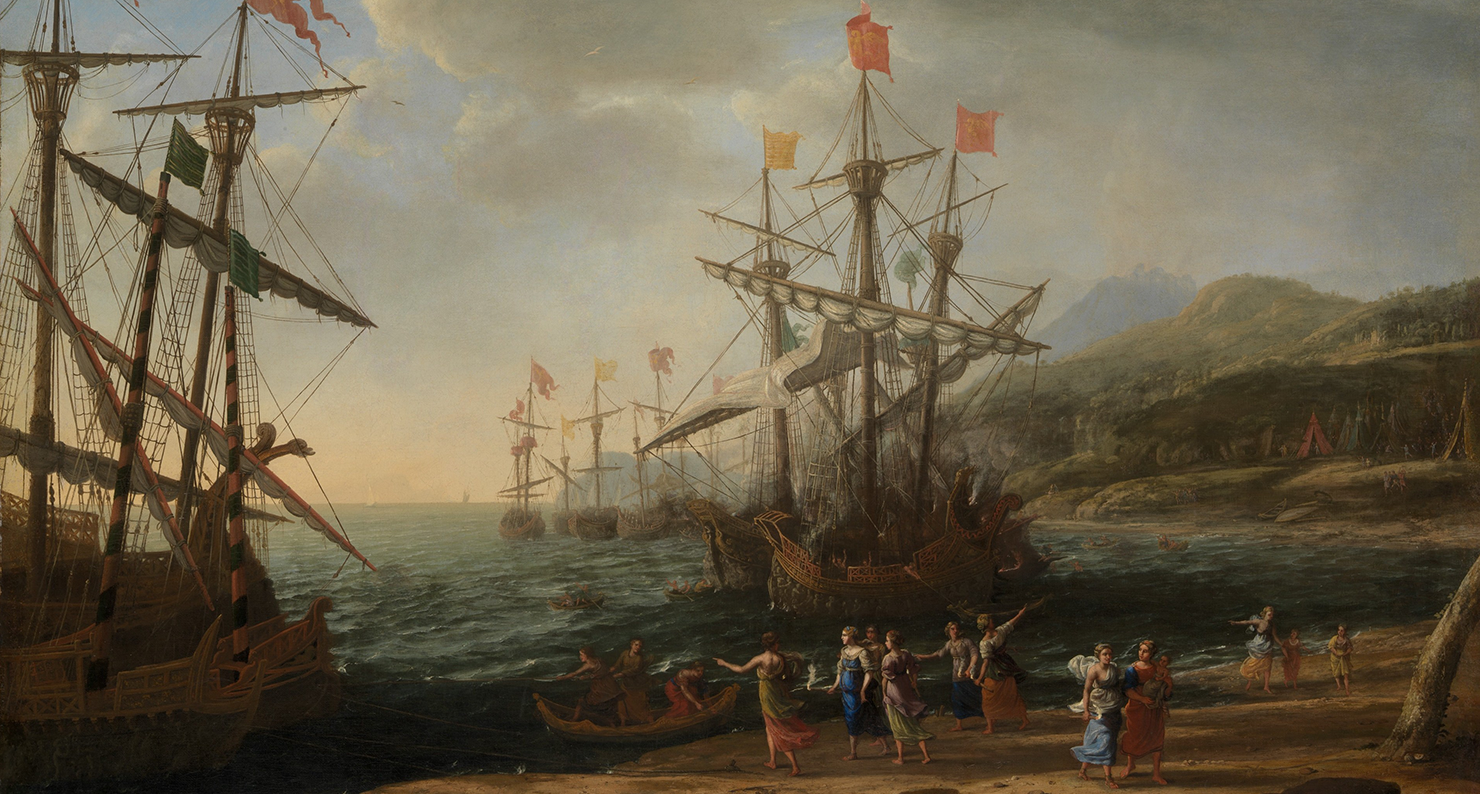
The Trojan Women Setting Fire to Their Fleet (detail), by Claude Lorrain (Claude Gellée), c. 1643. The Metropolitan Museum of Art, Fletcher Fund, 1955.
Amateur archaeologist Heinrich Schliemann was wandering around an ancient mound in northwestern Turkey one morning in May 1873, observing his workers’ digging. He was certain that they were excavating ancient Troy but had not yet been able to convince all of the doubters.
He suddenly noticed one of the workers unearthing a copper pot, behind which he could see the glint of gold. Dismissing the worker, he and his wife Sophia “cut out the treasure with a large knife,” working quickly because a large section of earth above them looked like it was about to cave in on them at any moment.
Sophia gathered the objects together in her shawl and carried them into their house, where the two of them catalogued the objects and realized what they had just found—a king’s treasure of gold necklaces, rings, and earrings, including two diadems, a headband, sixty earrings, and nearly nine thousand smaller ornaments. There were also cups, bowls, and other vessels made of gold, silver, and electrum, including a solid gold sauceboat, which is one of only two that has ever been found, and a golden vessel in the shape of a pomegranate. And there were other objects as well—a copper shield and vase; thirteen spearheads; fourteen battle-axes; daggers, a sword, and other objects of copper or bronze; stone hilts that probably belonged to bronze swords; and a multitude of other items, the like of which has never been found together elsewhere in the world.
They crated everything up, smuggled the treasure onto a boat, and sent it back to their residence in Athens. There, Sophia put on most of the jewelry that they had found, and they took a photograph of her wearing “Priam’s treasure,” which remains one of the most iconic images in archaeology to this day.
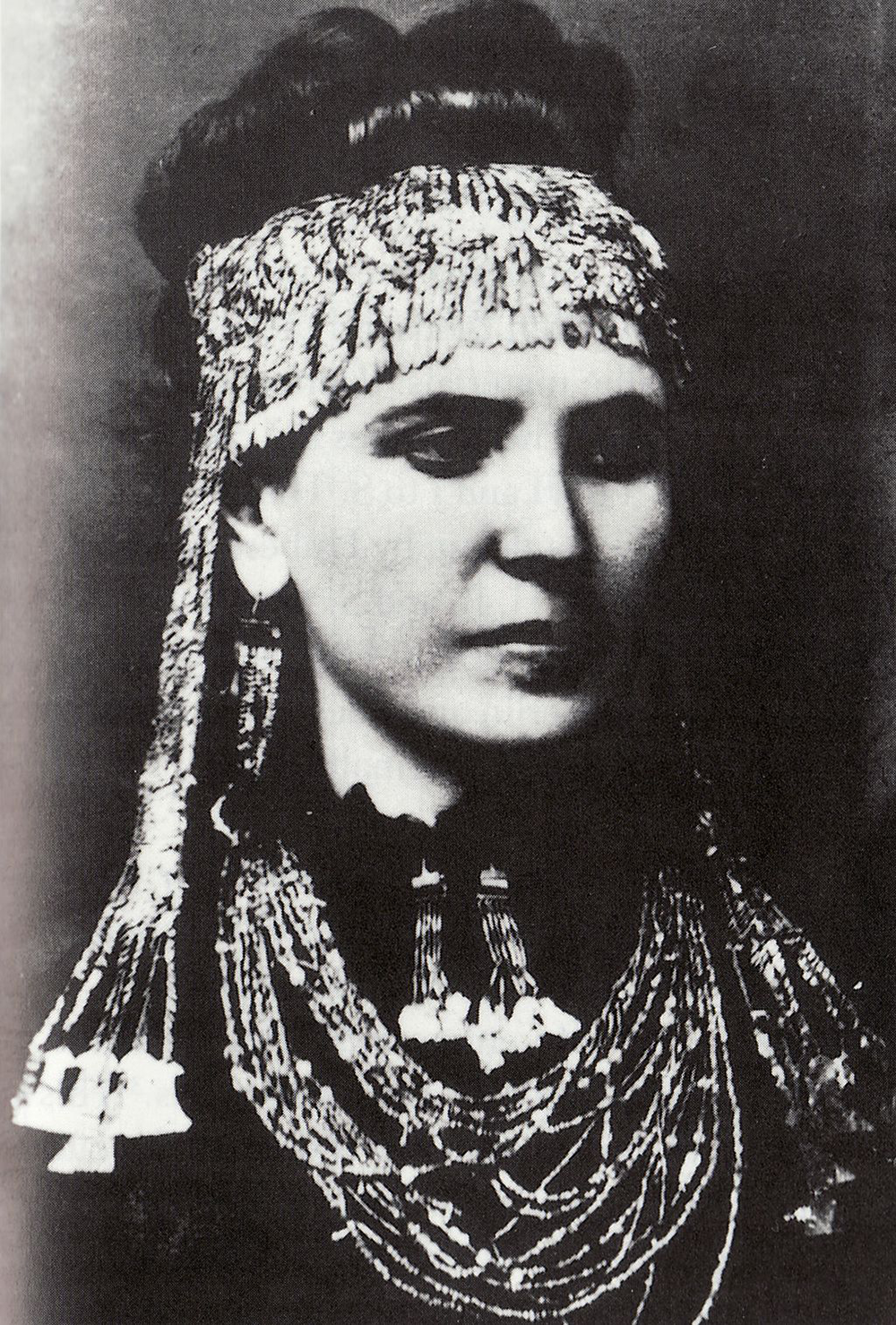
What we know about the Trojan War comes primarily from Homer’s Iliad. Homer’s story is rich in detail and yet scholars continue to question it. Was there an actual, historical Trojan War that served as a basis for Homer’s epic? And could archaeological evidence for it be found? The ancient Greeks were divided on whether the Trojan War had taken place, and if so, when it had been fought. Most classical scholars of nineteenth-century Europe were convinced that the Trojan War had not taken place and that it was completely made up by Homer.
Schliemann was intent on finding Troy and proving that the Trojan War had taken place. Much later, Schliemann claimed that he first decided to do so in 1829, at the age of seven. He was in his mid-forties before he had earned enough of a fortune to retire and devote the rest of his life to finding evidence for Troy and the Trojan War. In 1868 Schliemann took a trip to Greece and then proceeded on to Turkey. He says that he traveled around northwestern Turkey with Homer in one hand, looking for a site that was small enough so that Achilles could have chased Hector around it several times and that had both hot and cold springs, to match the description given by Homer.
He looked at a number of sites that had been suggested previously, but none seemed to quite fit the bill. Then he met the U.S. vice consul to Turkey, Frank Calvert. Calvert had also been looking for Troy and thought that he had found it. In fact, he had already bought the ancient mound, which now had the modern Turkish name Hissarlik, meaning “Place of Fortresses.”
Calvert had begun some preliminary excavations at the site but didn’t have enough money to continue working properly. Schliemann, on the other hand, had plenty of money and was happy to join forces with Calvert. Once they began excavating and Schliemann convinced himself that the mound was indeed the site of ancient Troy, he deliberately left Calvert’s name out of all of his subsequent official announcements, lectures, and publications, thereby claiming the fame and glory for himself.
The first excavation season by Schliemann at Hissarlik began in April 1870. He didn’t yet have an official excavation permit from the Turkish authorities, but that didn’t stop him. He didn’t find much that season, or the next. So, in 1872, with the help of a large team of local workers, he launched his greatest assault on the ancient site. This took the form of a huge trench that his workers dug right across most of the mound and down to a depth of about forty-five feet. Today it is known as Schliemann’s Great Trench and is still visible as a huge gash in the middle of the site.
Archaeology was still in its infancy at that time. Even though excavations had been ongoing at Pompeii for more than a century, there wasn’t that much digging going on elsewhere in the 1870s. But there were people who were knowledgeable, including Calvert, who warned Schliemann that such reckless digging might result in catastrophe.
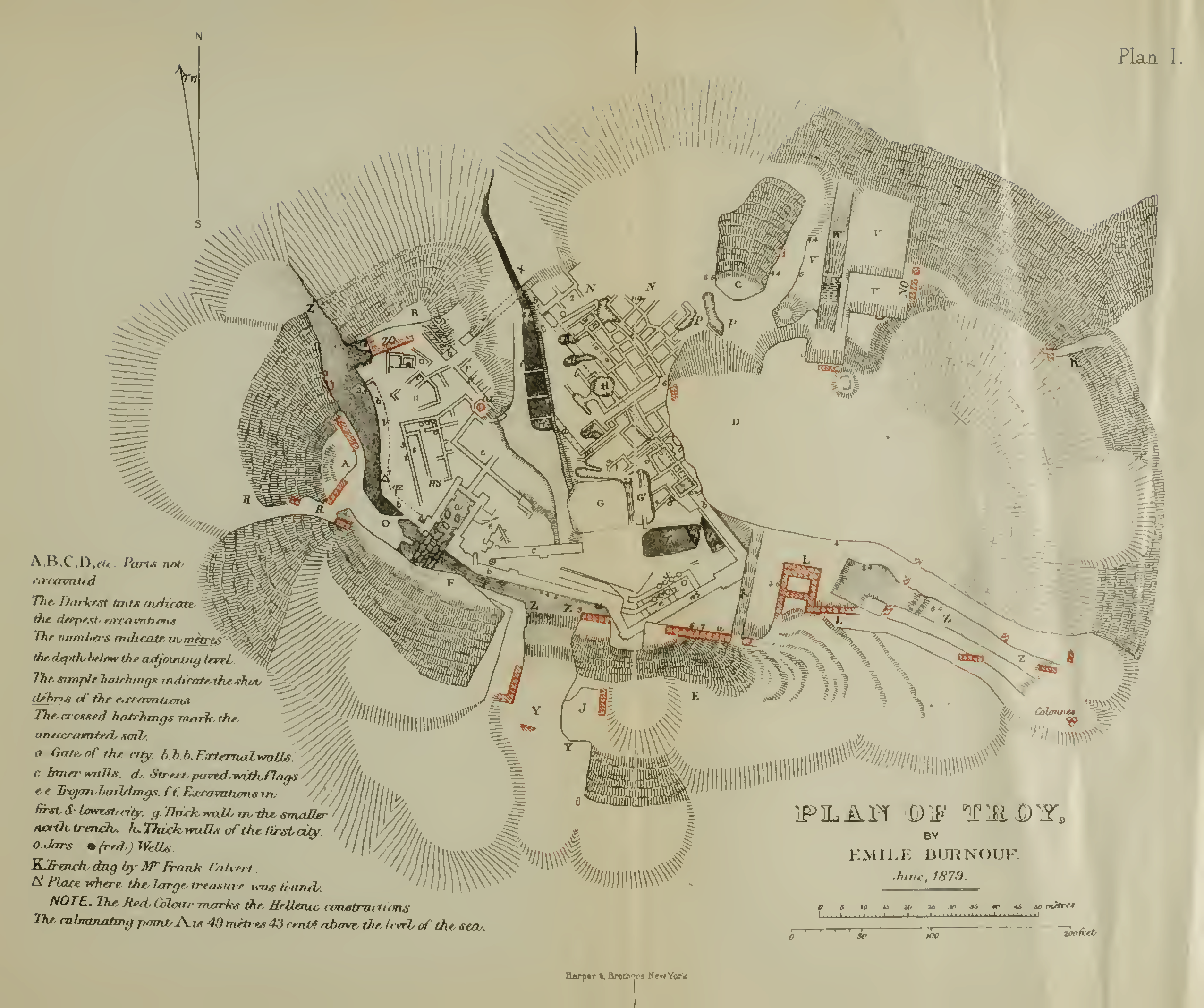
In the Great Trench, Schliemann and his workers went down, down, down; right through all sorts of buildings and stratigraphic levels. It turned out that there were nine cities buried one on top of another in the mound, although Schliemann thought at first that there were only six. He stopped at the second city from the bottom, which he called the “Burnt City.” He was convinced that this was the city that Priam had ruled in the Iliad. But he was wrong. We now know, on the basis of pottery analysis and carbon-14 dating, that this level of excavation, known as Troy II, dates to about 2400 BC, during the Early Bronze Age, more than a thousand years before the Trojan War would have been fought.
If one stands at the bottom of the Great Trench today, at the level where Schliemann and his workers stopped digging, and looks straight up, it is possible to see—way high above—a level that contains a building made out of huge blocks of stone. It’s just a few feet below the top of the mound, shaded from the sun by the limbs and leaves of a slender tree now growing on the modern surface. This is a palace that dates to the Late Bronze Age, the time period for which Schliemann was looking.
Most of that palace, however, is missing. In his haste, Schliemann and his workers dug right through the stone walls of Priam’s palace and threw most of it out on their dirt pile. If we were to dig in that spoil heap now, it is highly likely that we would find all sorts of things from the Troy of Priam and Hector, including perhaps clay tablets used by ancient scribes.
The story that he told about the day he and Sophia found the treasure has long been repeated in introductory archaeology textbooks, although it is unlikely to be true. Schliemann later admitted that he lied about Sophia’s role in his story. She wasn’t even at the dig on the day that he claims to have found the treasure. Some scholars have also suggested that Schliemann didn’t find the treasure all in one place. Instead, they think he gathered the best of his finds from the entire season and announced to a gullible public that he had found them all together as a single treasure. Moreover, since the objects were found in Troy II, they are a thousand years too early to have belonged to Priam.
Schliemann continued to dig at Troy throughout the 1870s and 1880s, though he also was digging at Mycenae at that time, looking for material remains of King Agamemnon. To help him at Troy, he hired Wilhelm Dörpfeld, an architect with some previous archaeological experience, who eventually persuaded Schliemann that he had been wrong and that it was actually the layers called Troy VI or Troy VII at Hissarlik that he should have been investigating all along. Schliemann began to make plans for an additional attack on the mound, focused on these later levels, but on Christmas Day in 1890, he collapsed on a street in Naples and died the next day.
It was left to Dörpfeld to carry on. And so he did, with the financial assistance of Sophia Schliemann, who wanted him to continue her husband’s work at the site. He concentrated on excavating the remains that Schliemann had left untouched, mostly around the edges of the mound. As it turned out, those remains were extremely impressive. He unearthed tall stone walls, each several meters thick, that would have stymied any attackers, and large gateways allowing entrance to the interior, but only after one got past the guards.
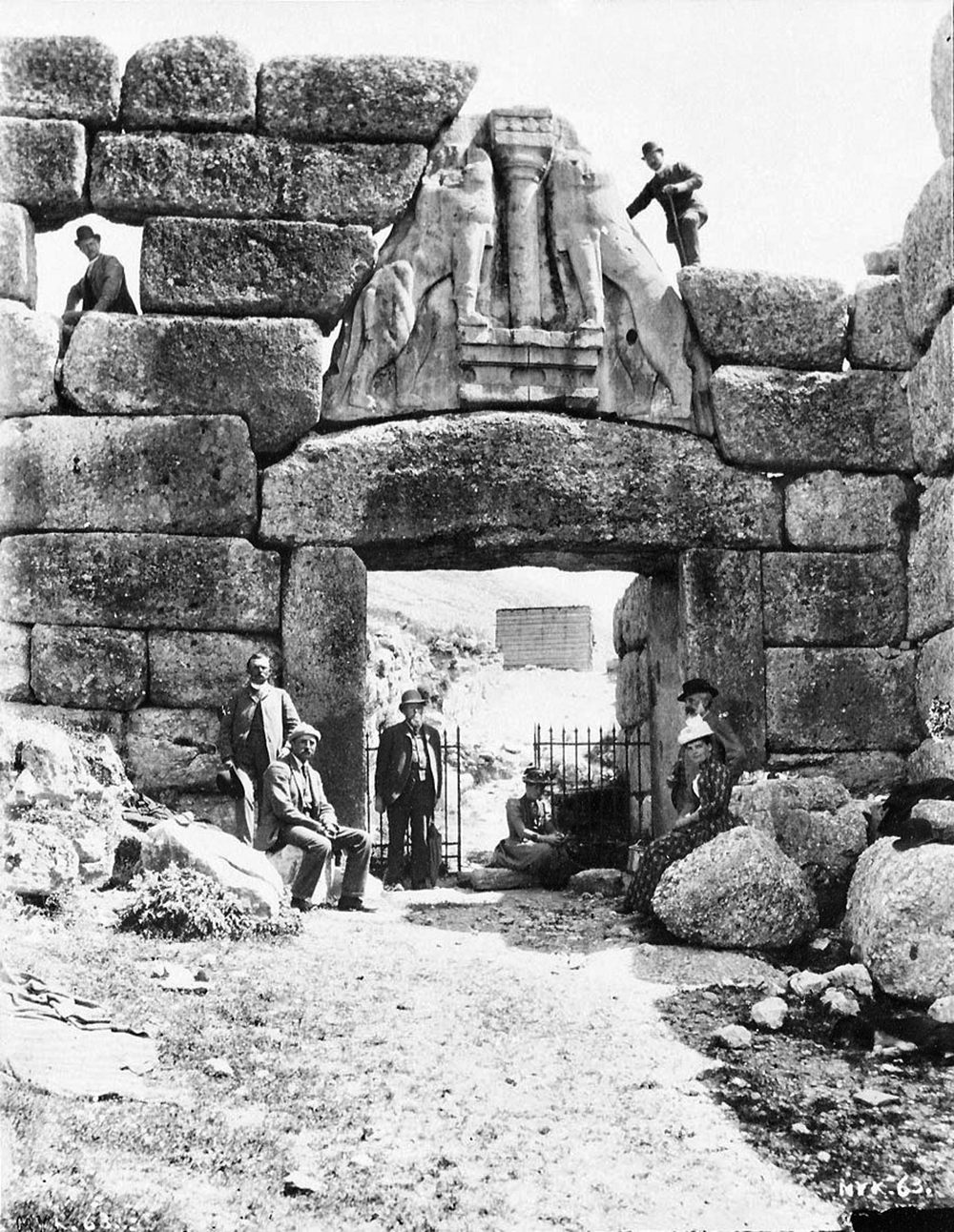
These were the remains of Troy VI, which seems to have lasted for nearly five hundred years, from about 1700 BC to 1250 BC. Dörpfeld found numerous phases of the city, which he labeled “a” through “h.” The last phase, Troy VIh, showed signs of an almost-complete destruction of the city. For Dörpfeld, this was the evidence for the Trojan War that they had been seeking. He ended his excavations and published his results.
In the meantime, travelers venturing elsewhere in Turkey, especially to the inland central plateau, had been finding the ruins of another ancient civilization. Back in 1879, while Schliemann was still excavating at Troy, a British Assyriologist named A.H. Sayce suggested a daring hypothesis—that the ruins belonged to the ancient Hittites. The hypothesis was daring because the Hebrew Bible seemed to place the Hittites in the region of Canaan.
In 1906 excavations began at what turned out to be the capital city of the Hittites—Hattusa, located by the modern-day town of Bogazköy, 125 miles to the east of Ankara. Within a year, the archives of the city began to be uncovered; thousands of clay tablets that included treaties, records, and royal letters. It turned out that the Hittites had been active across Anatolia from about 1700 to 1200 BC. They had even held territory in northern Syria, which is why the later biblical writers placed them in that region.
Among the tablets are a few that document the ongoing troubles that the Hittites had with a small vassal kingdom located in northwestern Anatolia, which they called Wilusa. Eventually, sometime early in the thirteen century BC, probably about 1280 BC, the Hittites signed a treaty with the king of Wilusa, a man named Alaksandu.
It was not long after this tablet was deciphered that some scholars began suggesting that this was a Hittite reference to the same man whom Homer calls Alexander (Paris) of Ilios and who was responsible for beginning the Trojan War because of his romance with Helen. Philologically, Wilusa is close to the Greek name (W)Ilios—the original “W” sound in Greek, known as a digamma, dropped out over time, so that by Homer’s time it was simply Ilios. And, of course, Alaksandu sounds very much like Alexander.
Although it is by no means clear that the two identifications are correct, at the very least these tablets show that the Hittites were involved with an area, and a city, in northwest Anatolia that they called Wilusa. The tablets also record that at least four wars were fought here, the last three of which were all during the thirteenth century BC, in other words the probable time of the Trojan War. For those scholars who believed that Wilusa is the Hittite name for Troy, this provided additional data that the Trojan War could very well have been an historical event, rather than simply the stuff of myth and legend.
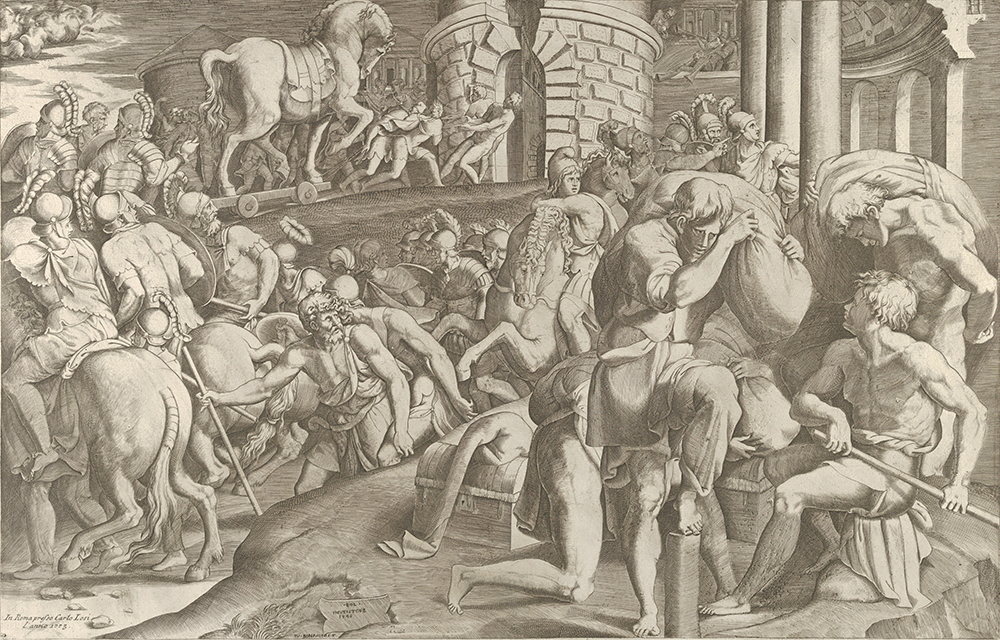
Not everyone was convinced, however, by Dörpfeld’s argument that Troy VIh was Homer’s Troy. Archaeologist Carl Blegen examined Dörpfeld’s results and concluded that an earthquake caused the destruction of Troy VIh, not warfare. He decided as he did because a number of walls were found off-kilter, with large stones thrown about, which he thought could have been caused only by Mother Nature. On the other hand, it looked to him as if the first phase of the next level, known as Troy VIIa, was a city that had been besieged and then destroyed by an army. So he reopened the excavations at Hissarlik in the 1930s in an attempt to see whether he was right.
Now there was even less left for him to dig, since Dörpfeld had excavated much of what Schliemann had left untouched. But Blegen found enough to convince himself that Troy VIIa had been destroyed by humans, in a protracted siege. And his evidence is fairly convincing, including arrowheads buried in the walls, bodies left lying in the streets, and other indications that at least one major battle had taken place. And the timing was still consistent; this city had been destroyed about 1180 BC or so, which was still within the timeframe suggested by the ancient Greeks.
Blegen may well have been correct. But fifty years went by, a new generation of archaeologists emerged, and a new team decided to investigate the mound of Hissarlik all over again, beginning in 1988. This time it was an international team of archaeologists, led by Manfred Korfmann from the University of Tübingen, investigating the Bronze Age remains, and Brian Rose from the University of Cincinnati, investigating the post–Bronze Age remains.
In 1993, more than a century after the legendary excavations at Troy by Heinrich Schliemann, Korfmann announced that remote sensing images made using a cesium magnetometer indicated the presence of a huge buried wall that ran around Hissarlik, at a distance of about 1300 feet from the citadel. This, they announced, was probably the great wall of the city that had kept Agamemnon, Achilles, and the other Mycenaean Greeks out for ten years during the famous Trojan War.
When they went to excavate the wall, though, it wasn’t there. In its place was a ditch, measuring up to six feet deep in places. Over the centuries, the ditch had filled up with all sorts of junk, from broken pottery to stones to random bits of garbage. These had shown up on their remote sensing images as a solid mass running around the city.
Korfmann and his team soon realized that additional remote images indicated the existence of an enormous Lower City for Troy that lay beneath modern agricultural fields, which nobody had suspected was there. It turns out that all the previous archaeologists, from Schliemann to Dörpfeld to Blegen, had simply been excavating the citadel—or upper part—of the city, where the king and his direct family and retinue would have lived. The remains that Korfmann’s team found increased the size of the city at least tenfold, showing that it covered at least fifty acres with a population of between four thousand and ten thousand inhabitants at the end of the Late Bronze Age, which established it as a city that would indeed have been worthy of a ten-year-long siege, if Homer’s story has any truth to it. Korfmann began referring to the city in his scholarly publications as Troy/Wilusa—a nod to the Hittite records, which he believed were a reference to this city.
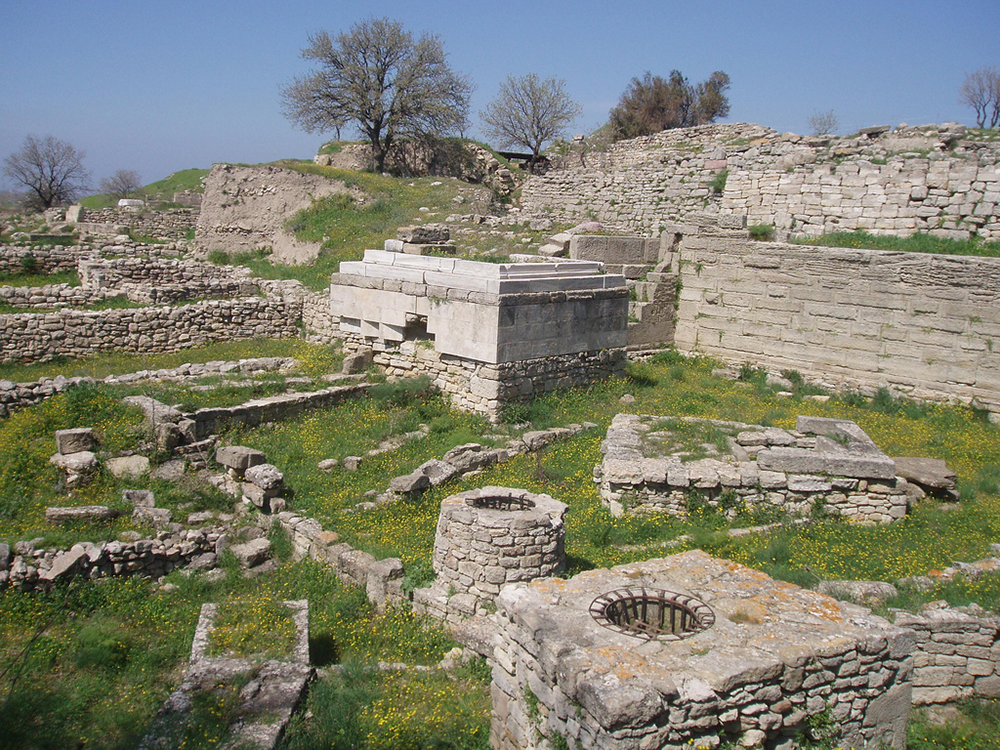
Other findings by Korfmann’s team seemed to confirm Blegen’s earlier work. For example, in both the citadel and the Lower City, they also found evidence for earthquake destruction in Troy VIh and human destruction—that is, warfare—in Troy VIIa. In one case, they found a house from Troy VIh that had been destroyed by the earthquake and then a house from Troy VIIa that had been built right on top of its ruins, only to be destroyed in war.
Korfmann’s work also confirmed Blegen’s earlier findings in other ways. After the Troy VIIa city was destroyed in about 1180 BC, the next one was occupied by what seem to be a completely new people. In this phase, which archaeologists call Troy VIIb, we see completely new types of pottery, new architecture, and other material culture, including an inscribed seal that has the first writing ever found at Troy.
These are all indications that the inhabitants of the previous city had been completely replaced by a new group. Therefore, it is possible to see the human destruction of Troy VIIa as being evidence of the stories of Homer about the Trojan War. In his story, though, Homer seems to have also added in elements from Troy VI, so that he described the beautiful buildings and high walls of the earlier city but the destruction of the later city, thereby compressing the two cities into one, which was his prerogative as an epic poet.
It may even be that the Trojan Horse is a poetic metaphor for the earthquake that leveled Troy VIh, for the Greek god of earthquakes was Poseidon. Just as the goddess Athena was represented by an owl, so a horse represented Poseidon for the Greeks. At least that’s what a German scholar named Fritz Schachermeyer suggested back in the 1950s.
As the Hissarlik digs continued, the post–Bronze Age team also found a lot of new material, including a larger-than-life statue of the Roman emperor Hadrian in 1993 and a large marble head of Augustus in 1997. The later Hellenistic Greeks and then the Romans had built upon the citadel and established a nicely gridded city down below, which Korfman had found in addition to the Bronze Age remains in this area.
These later inhabitants were also convinced that this was the site of ancient Troy and, in fact, they gave it the name “New Troy” in both Greek and Latin. Even Alexander the Great came to visit and pay his respects, as did Julius Caesar and others over the centuries. It was initial discoveries from these later periods that first persuaded Frank Calvert, and then Heinrich Schliemann, that they were digging in the right place.
Adapted from Three Stones Make a Wall: The Story of Archaeology by Eric H. Cline. Copyright © 2017 by Princeton University Press. Reprinted by permission.
Explore Discovery, the Spring 2017 issue of Lapham’s Quarterly.